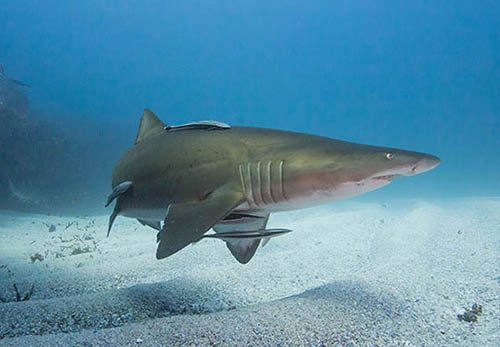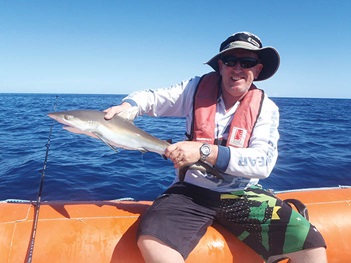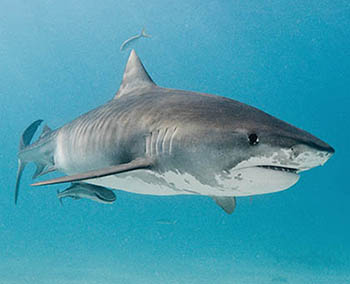A report card on the health of Australia’s shark and ray populations gives a tick to most species under Australia’s care and identifies where action is needed
By Bianca Nogrady
 Greynurse shark
Greynurse sharkPhoto: Shutterstock
One of the more heated debates to stir the blood of Australian shark experts has been the question of the health of the nation’s Greynurse Shark (Carcharias taurus) populations. In 2003, experts from the east coast were calling for the species to be listed as critically endangered. But their colleagues from the west were adamant that populations were in good health. It took five days of intense discussion to reach the conclusion that there were in fact two populations, or stocks, of Greynurse Shark, not one.
This is just one example of the complexity faced by scientists when assessing the overall health of Australia’s shark and ray populations. Tackling many of these challenges head-on is a new report funded by the FRDC.
Shark futures: A report card for Australia’s sharks and rays has built the most comprehensive picture yet of the status of Australian sharks and shark-like rays, about half of which are endemic to Australian waters.
The report has assessed 194 species, or 198 stocks, which includes the two independent populations of the Greynurse Shark, Endeavour Dogfish (Centrophorus moluccensis), Dusky Shark (Carcharhinus obscurus) and Sandbar Shark (Carcharhinus plumbeus).
The report was commissioned in response to ongoing concerns about the status of shark and ray populations, and to assess Australia’s efforts to ensure the wellbeing of those populations under its jurisdiction.
At a basic level, sharks are fish from the taxonomic class Chondrichthyes, and the subclass Elasmobranchii, which also includes rays and skates. Modern sharks and rays fit into the clade Selachii, of which there are more than 1200 species worldwide.
Most are under one metre long, and some are as small as the human hand. Their lightweight cartilaginous skeleton is one defining feature, but another is the row of gills on either side of their heads.
While bony fish only have one gill opening, sharks have five to seven pairs on each side.
Many sharks also give birth to live, well-developed young – something that distinguishes them from bony fish and can also make them more vulnerable, says Colin Simpfendorfer, professor of marine biology at James Cook University and lead author on the report.
“What that means is that some sharks have fairly limited reproductive output on an annual basis, and that really limits their ability to sustain fishing and recover from overfishing.”
Australian species assessed
 Colin Simpfendorfer,
Colin Simpfendorfer,Professor of marine biology James Cook University
Overall, Shark futures: A report card for Australia’s sharks and rays tells a good news story: 124 of the 198 stocks are assessed as being in a sustainable state, and nine stocks that have been in decline in the past now show signs of recovery, including the eastern stock of the Endeavour Dogfish.
Twenty-one species were assessed as doing better in Australian waters than they are globally.
However, of concern, 18 stocks were classified as depleted. Those 18 are either protected or already have plans in place to aid their recovery.
“To me, this is a signal that Australia is good at knowing when a species needs attention and doing something about updating its status, and putting management in place,” Colin Simpfendorfer says.
“We actually have very good fisheries management and enforcement of fisheries rules in this country.”
The report recommends further efforts to improve management of and research into the two species that don’t have management plans – Whitefin Swellshark (Cephaloscyllium albipinnum) and Colclough’s Shark (Brachaelurus colcloughi). Both are caught incidentally in fisheries.
“One of the things that we know is that where we have most of our problems is not with our target species, but with those that are taken as incidental bycatch,” Colin Simpfendorfer says.
Six species were also assessed as depleting, which indicates a decline in abundance, but not yet to a state where the population is in jeopardy.
The report recommends careful monitoring of these populations in the future.
Data gaps
It is not always easy to identify, classify and assess the health of shark species, particularly those found in deeper waters. The FRDC’s shark report lists 41 stocks as ‘undefined’, where there simply was not enough information for experts to provide status assessments. The majority of these are rarely encountered deep-water species.
“There are some sharks that are only known from one specimen caught in 1000 metres of water, so no matter how you look at that data it can only be undefined,” says Will White, senior curator of the Australian National Fish Collection at CSIRO and a co-author on the sharks and rays report.
Species from deep water are also less likely to encounter fishing, so are of less concern than those from shallower regions. Will White says species known to occur within particular fisheries should be prioritised for further research. “You need to overlay the threat to the distribution of the animals,” he says.
Taxonomy
 Colin Simpfendorfer conducting shark research for James Cook University.
Colin Simpfendorfer conducting shark research for James Cook University. Photo: James Cook University
Identifying the species is the crucial first step in the stock assessment process.
In the 1990s, when the book Sharks and Rays of Australia (an FRDC-funded project) was first published, it listed more than 60 species as “possibly undescribed”. By the second edition, published in 2009, experts had put names to most of those species, Will White says.
“The fundamental requirement of any sort of study is that you need to know what the animals are,” he says. “We are in a pretty good position with this in Australia now, so there are only a handful that we are working on now.”
The importance of getting the taxonomy right is illustrated by the case of the Whitefin Swellshark. For a long time, it was mistakenly identified as the Northern Draughtboard Shark, which is a sustainably managed species.
Then when researchers realised the Whitefin Swellshark was a different species, things changed completely and it is now classified as depleted.
Assessment approach
The process of writing Australia’s report card on sharks followed the well- established approach used by the International Union for the Conservation of Nature – or IUCN – for curating its Red List of Threatened Species.
The organisers held a workshop of 23 of Australia’s leading shark and ray experts, who all brought the latest information and evidence on their species of interest to the table. The group then applied the IUCN Red List criteria to the shark species being considered, to establish the health of each population.
It can be an intense process, says Will White. “There are lots of discussions, and you do get some strong disagreements, but you always come out with a stronger assessment at the end.”
The IUCN sets a high bar for the evidence required to show a species is threatened, he says, which means there is very little chance that threat is being overstated. The report also incorporated Australian categories and criteria for sustainability, using the FRDC’s Status of Australian Fish Stocks (SAFS) reports.
Future action
While there’s plenty of good news to be found in this report, there is still work to be done for the species identified as depleting, depleted or of unknown status, Colin Simpfendorfer says.
“Because of the life history of these animals, some may take 20 or 30 years to reach maturity and have very small numbers of young, and so the recovery is going to be slow,” he says. “They could remain depleted for quite some time, even though the populations are starting to potentially recover.”
Will White says now the report card is in, the next step is an action plan, which should include repeating this assessment process on a more regular basis. While the second National Plan of Action for the Conservation and Management of Sharks has been in place since 2012, the report card will be an invaluable tool to inform future action.
Will White stresses that it is important to work out how some of the at-risk species might be linked, as that could offer the potential for synergies in research focus and management plans, and the best return on research investment to address threats.
The National Plan of Action for the Conservation and Management of Sharks 2012 can be viewed here.
| Status of Australia’s shark stocks | |
| 194 species assessed | 6 depleting stocks |
| 124 sustainable stocks | 18 depleted stocks |
| 9 recovering stocks | 41 undefined stocks |
Reproductive diversity
Sharks are unusual in the animal world in that they reproduce in three different ways, depending on the species.
Some species are oviparous – the females lay fertilised eggs outside their body. The Port Jackson Shark (Heterodontus portusjacksoni) is an example of this. It produces eggs with a distinctive corkscrew casing that is often found washed up on beaches. It is assessed as sustainable in Shark futures: A report card for Australia’s sharks and rays.
Some shark species are ovoviviparous – they produce eggs that stay in the female and hatch inside the parent with no placental connection. The Gummy Shark (Mustelus antarcticus) and School Shark (Galeorhinus galeus) are both examples of this.
Gummy Sharks have ‘litters’ of around 14 pups at a time, but can produce as many as 57 every one to two years, and the species is viewed as a sustainability success story.
In contrast, the School Shark, which has been commercially targeted in the past, can produce 15 to 43 pups, but only reproduces every three years and takes longer to reach maturity. It is now assessed as depleted in the 2018 Status of Australian Fish Stock (SAFS) reports, and a management plan has been put in place to help restore its numbers.
Some sharks are also viviparous – they give birth to live young, in the same way that mammals do. This includes the commercially fished Whiskery Shark (Furgaleus macki), which also matures quickly, has large litters of young, and gives birth every two years. It is assessed as sustainable in the SAFS reports.
The Tiger Shark conundrum
 Tiger Shark
Tiger SharkPhoto: Shutterstock
Like the Greynurse Shark, the Tiger Shark (Galeocerdo cuvier) presents something of a conundrum. Shark futures: A report card for Australia’s sharks and rays identifies it as depleting, but there is no management plan in place for the species, and it is also a target of shark control programs in Queensland.
The reason may be that it too has different populations experiencing different levels of threat. Colin Simpfendorfer says evidence suggests populations in the southern Queensland and NSW region are declining, but in northern Australia and the west coast, they’re doing reasonably well.
“It’s a sign that, again, we need to understand this situation more; we need to think about whether we need to put some sort of regulation in place in terms of making sure that enough of these animals are surviving or avoiding capture,” he says. “That gets complicated because they are a target of the shark control program in Queensland, so it’s going to be more difficult to resolve, because you have this tension between human safety and conservation and management outcomes.”
FRDC Research Code: 2013-009
More information
Colin Simpfendorfer
colin.simpfendorfer@jcu.edu.au





